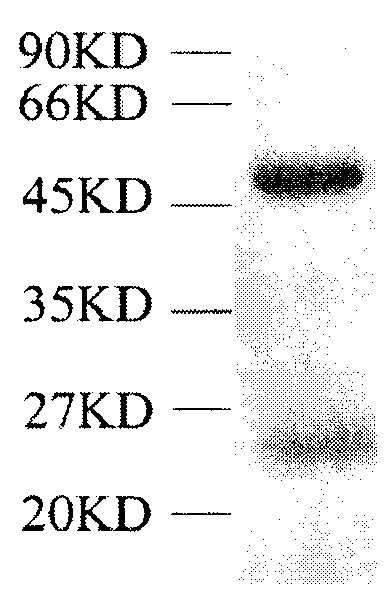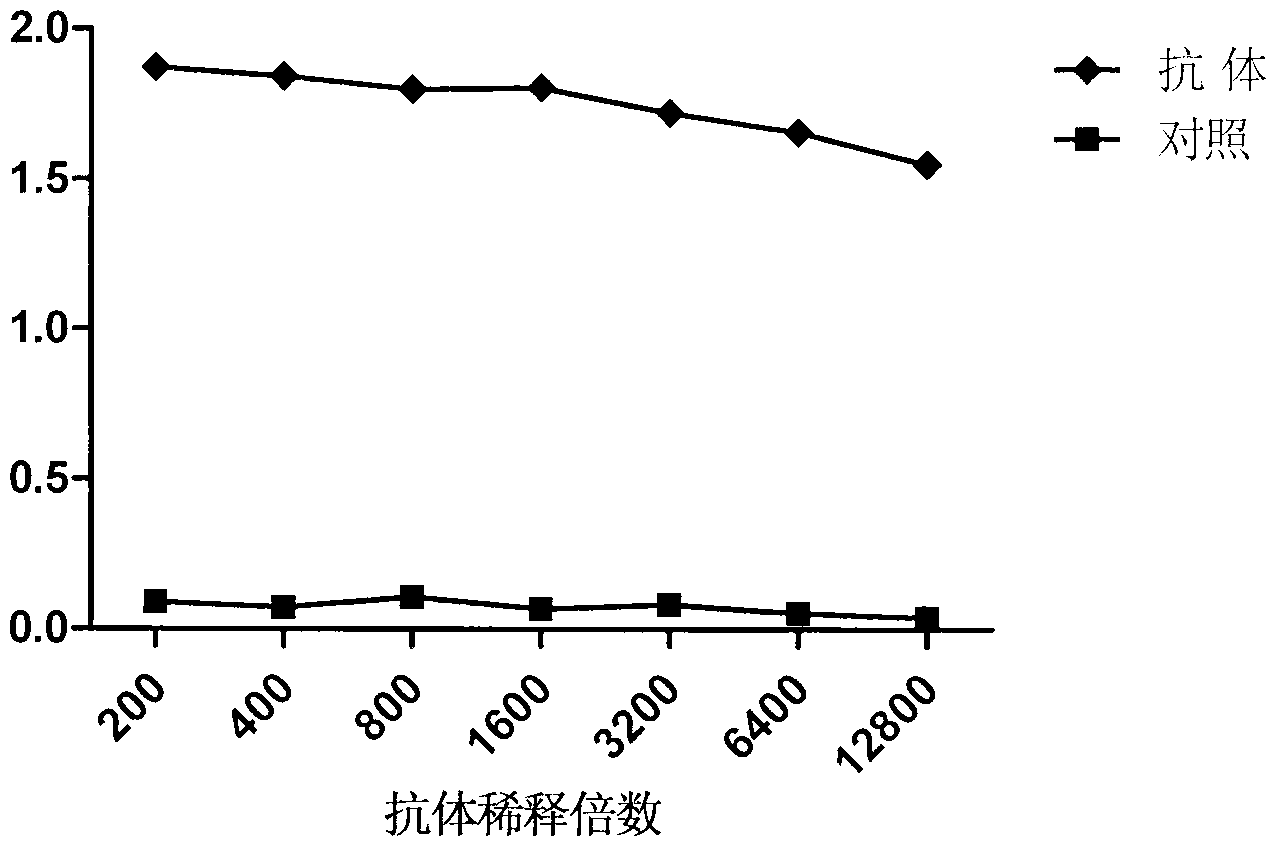Mouse anti-human CEA (Carcino-Embryonic Antigen) monoclonal antibody and hybridoma cell strain secreting same
A hybridoma cell line and monoclonal antibody technology, applied in the field of bioengineering, can solve the problem of no early diagnosis value for tumor diseases
- Summary
- Abstract
- Description
- Claims
- Application Information
AI Technical Summary
Problems solved by technology
Method used
Image
Examples
Embodiment 1
[0022] Example 1: Obtaining of hybridoma cell line 10E1 and the monoclonal antibody it produces
[0023] 1. Antigen preparation
[0024] (1) Obtain the target gene
[0025] In this embodiment, according to the coding frame of the gene sequence of CEA (NM_004363.2), design 1 pair of specific primers:
[0026] Primer 1: 5'-AATGGATCCATGGAGTCTCCCTCGGCCC-3' (SEQ ID NO: 1)
[0027] Primer 2: 5′-ATCCTCGAGCTATATCAGA GCAACC-3′; (SEQ ID NO: 2) Trizol Reagent was used to extract total RNA from human adipose tissue, and the total RNA was reverse-transcribed into cDNA, and the CEA gene was amplified by PCR using cDNA as a template.
[0028] (2) Construction of recombinant expression vector
[0029] The PCR product obtained in step (1) was double digested and recovered, and ligated into the expression vector PET28a under the action of T4 DNA ligase to construct the recombinant plasmid PET28a-CEA.
[0030] (3) Obtain expression strains containing recombinant expression plasmids
[0031]...
Embodiment 2
[0051] Example 2: Application detection of monoclonal antibody immunohistochemistry
[0052] Using CEA monoclonal antibody, pathological sections were made according to conventional methods, and immunohistochemical staining was performed on paraffin sections of human colon adenocarcinoma.
[0053] The specific method is:
[0054] (1) Dewaxing
[0055] The slices were dewaxed in xylene I, II, III in turn for 5 minutes each time, moved to absolute ethanol I, II for 4 minutes each, moved to 95% alcohol for 4 minutes, moved to 85% alcohol for 4 minutes Minutes, then moved to 70% alcohol to soak for 4 minutes, rinsed with running water for 2 minutes.
[0056] (2) Antigen retrieval
[0057] Put the washed tissue slices into a pressure cooker, add about 3000ml of citrate antigen repair solution (pH6.0), heat on high heat and boil, then turn to low heat and keep boiling for 3 minutes, then turn off the switch of the induction cooker for two minutes Finally, move the pressure cooke...
Embodiment 3
[0067] Example 3: Sequencing of variable regions of monoclonal antibodies
[0068] Synthesize the following primers based on the constant region sequence of the antibody gene:
[0069] zh07 5'-GGGGATATCCACCATGGRATGSAGCTGKGTMATSCTCTT-3' (SEQ ID NO: 3)
[0070] zhr11 5'-GACHGATGGGGSTGTYGTGCTAGCTGNRGAGACDGTGA-3' (SEQ ID NO: 4)
[0071] zl01 5'-GGGGATATCCACCATGGAGACAGACACACTCCTGCTAT-3' (SEQ ID NO: 5)
[0072] zlr05 5'-GGATACAGTTGGTGCAGTCGACTTACGTTTKATTTCCARCTT-3' (SEQ ID NO: 6)
[0073] Trizol Reagent reagent extracts 5×10 6 The total RNA of hybridoma cell 10E1 was reverse transcribed into cDNA. Use zh08 and zhr11 as primers to amplify the variable region of the heavy chain of the monoclonal antibody CEA by PCR, and use zl01 and zlr05 as primers to amplify the variable region of the light chain of the monoclonal antibody CEA by PCR. The PCR reactions are all hot-started. The reaction conditions are: 94°C for 5 minutes; 94°C for 45 seconds, 60°C for 45 seconds, 72°C for 1 minu...
PUM
 Login to View More
Login to View More Abstract
Description
Claims
Application Information
 Login to View More
Login to View More - R&D
- Intellectual Property
- Life Sciences
- Materials
- Tech Scout
- Unparalleled Data Quality
- Higher Quality Content
- 60% Fewer Hallucinations
Browse by: Latest US Patents, China's latest patents, Technical Efficacy Thesaurus, Application Domain, Technology Topic, Popular Technical Reports.
© 2025 PatSnap. All rights reserved.Legal|Privacy policy|Modern Slavery Act Transparency Statement|Sitemap|About US| Contact US: help@patsnap.com



